Quality of Monitoring Optimization in Underwater Sensor Networks through a Multiagent Diversity-Based Gradient Approach
Abstract
1. Introduction
- The first objective is to maximize the coverage of the sensor network by optimizing the placement of sensors. This involves designing a distributed algorithm that enables the sensors to communicate with each other and cooperate to achieve maximum coverage of the area of interest.
- The second objective is to reduce the redundancy of the sensor network by not only considering the correlation between sensors readings but also the diversity of the readings using the concept of determinantal point process.
2. Related Work
3. An Optimization Function for Water Quality which Minimizes Sensor Redundancy and Maximizes Diversity
3.1. Gradient Based on Covariance
3.2. Gradient of Diversity
3.3. Weighted Objective Function
3.4. Derivation of the Gradient of Diversity
3.5. Proof of the Convergence of the Gradient Controller
- Must be differential;
- Must be locally Lipschitz;
- Must have a lower bound;
- Must be radially unbounded or the trajectories of the system must be bounded.
4. Numerical Implementation and Experiments
4.1. Case of 10 Sensors
4.2. Case of 20 Sensors
5. Further Discussion
6. Conclusions and Future Work
- The impact of varying the number of agents on the performance of the system: While our approach showed promising results in improving the performance of QoM, it is important to understand how the number of agents affects the overall system performance. Future work could focus on varying the number of agents and evaluating the resulting impact on the performance of the system.
- Agent selection: Future work could explore the development of a more efficient algorithm for agent selection that reduces computational costs while still achieving high-quality optimization results.
- Evaluating the impact of environmental factors on the performance of the system: The performance of underwater sensor networks is often affected by various environmental factors such as water temperature, salinity, and turbidity. Future work could investigate how these environmental factors affect the performance of the multiagent diversity-based gradient approach optimization and identify ways to mitigate their impact.
- Extending the optimization to other QoM metrics: The multiagent diversity-based gradient approach optimization has been mainly focused on optimizing the energy efficiency of underwater sensor networks. Future work could explore the extension of the optimization approach to other QoM metrics such as latency, throughput, and reliability. As future work, we could also try to jointly optimize the communication cost and quality of monitoring.
- Machine learning techniques such as reinforcement learning and deep learning have shown promising results in optimizing various aspects of underwater sensor networks. Future work could explore the integration of these techniques with our optimization approach to further improve the performance of the system.
- Three-axis models: To improve our study and move close to the real world, a three-axis model will be considered in future works.
Author Contributions
Funding
Institutional Review Board Statement
Informed Consent Statement
Data Availability Statement
Conflicts of Interest
Appendix A. Environment 2


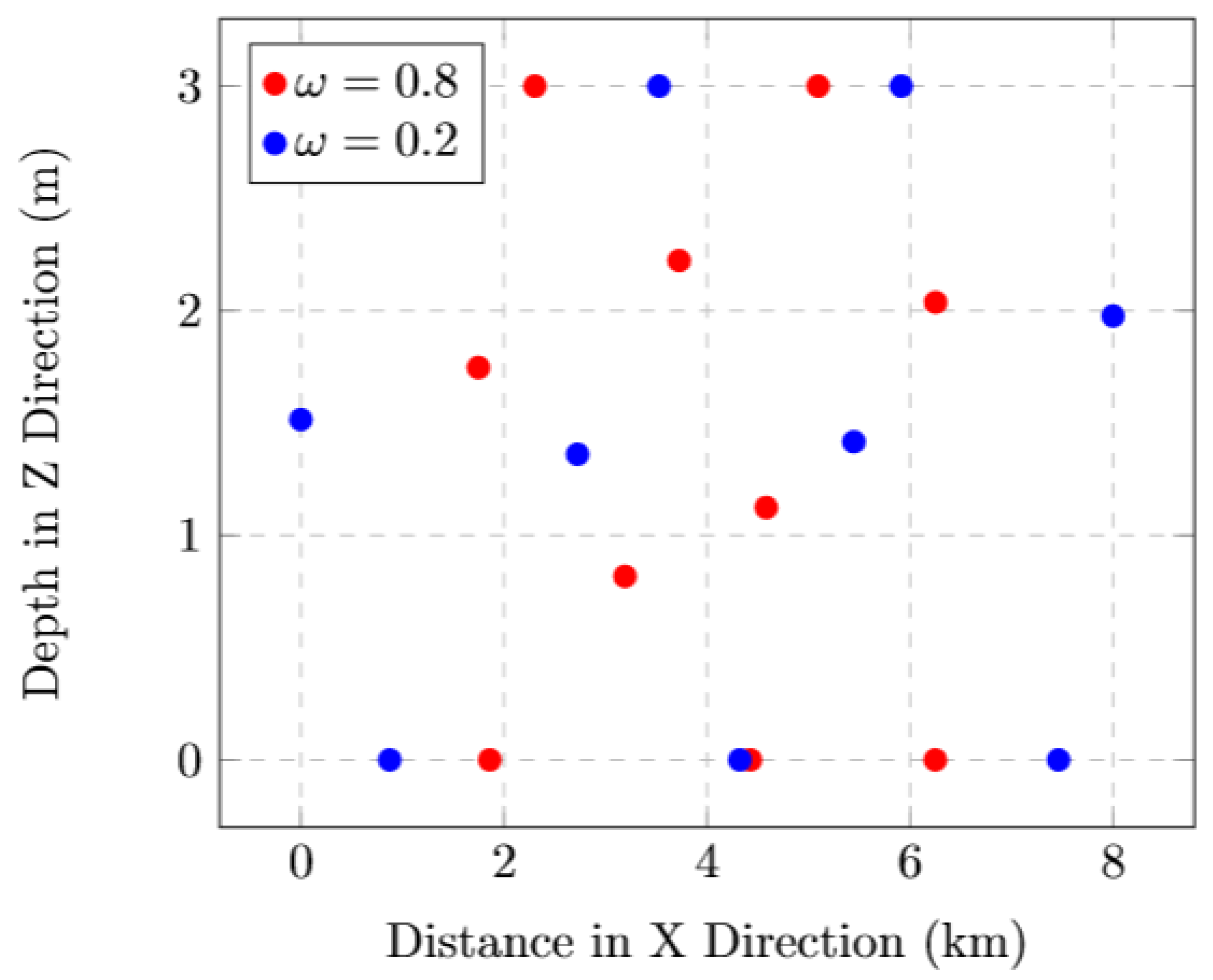


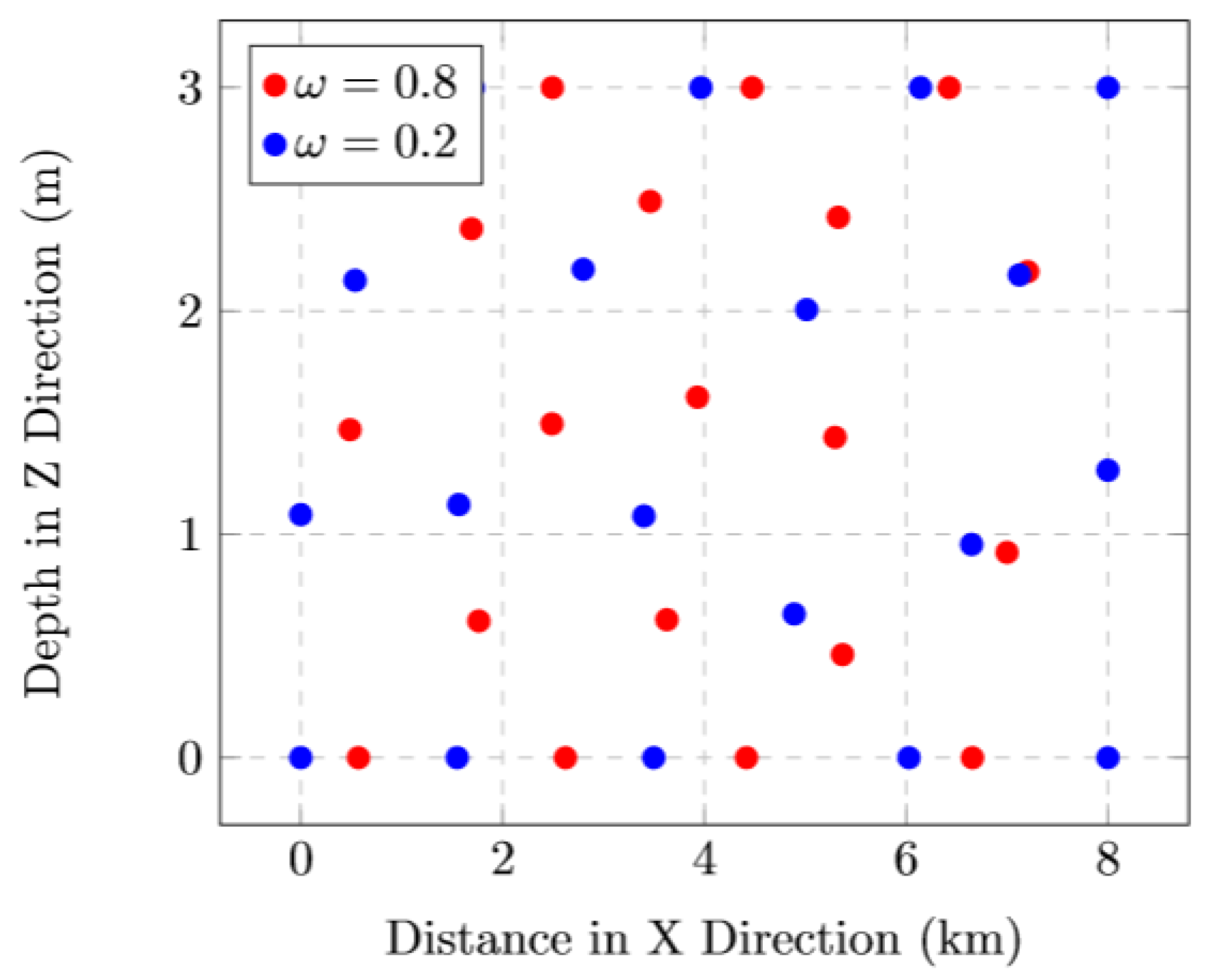
References
- Bayusari, N.; Adawiyyah, A.; Dwijayanti, S.; Hikmarika, H.; Husin, Z.; Suprapto, B.Y. Water Quality Monitoring System in Autonomous Underwater Vehicle Based on Internet of Things (IoT). In Proceedings of the 2021 8th International Conference on Electrical Engineering, Computer Science and Informatics (EECSI), Semarang, Indonesia, 20–21 October 2021; pp. 328–334. [Google Scholar] [CrossRef]
- Beshah, W.T.; Moorhead, J.; Dash, P.; Moorhead, R.J.; Herman, J.; Sankar, M.S.; Chesser, D.; Lowe, W.; Simmerman, J.; Turnage, G. IoT Based Real-Time Water Quality Monitoring and Visualization System Using an Autonomous Surface Vehicle. In Proceedings of the OCEANS 2021, San Diego—Porto, San Diego, CA, USA, 20–23 September 2021; pp. 1–4. [Google Scholar] [CrossRef]
- Gupta, O.; Goyal, N.; Anand, D.; Kadry, S.; Nam, Y.; Singh, A. Underwater Networked Wireless Sensor Data Collection for Computational Intelligence Techniques: Issues, Challenges, and Approaches. IEEE Access 2020, 8, 122959–122974. [Google Scholar] [CrossRef]
- Qian, Y.; Su, H.; Han, G.; Zhang, J.; Liu, J. Ecologically Friendly Full-Duplex Data Transmission Scheme for Underwater Acoustic Sensor Networks. IEEE Internet Things J. 2021, 8, 7676–7690. [Google Scholar] [CrossRef]
- Sendra, S.; Lloret, J.; Jimenez, J.M.; Parra, L. Underwater Acoustic Modems. IEEE Sens. J. 2015, 16, 4063–4071. [Google Scholar] [CrossRef]
- Felemban, E.; Shaikh, F.K.; Qureshi, U.M.; Sheikh, A.A.; Qaisar, S.B. Underwater sensor network applications: A comprehensive survey. Int. J. Distrib. Sens. Netw. 2015, 11, 896832. [Google Scholar] [CrossRef]
- Ali, A.; Ming, Y.; Chakraborty, S.; Iram, S. A Comprehensive Survey on Real-Time Applications of WSN. Future Internet 2017, 9, 77. [Google Scholar] [CrossRef]
- Anastasi, G.; Conti, M.; Francesco, M.D.; Passarella, A. Energy conservation in wireless sensor networks: A survey. Ad Hoc Netw. 2009, 7, 537–568. [Google Scholar] [CrossRef]
- Akkaş, M.A.; Sokullu, R. Wireless Underground Sensor Networks: Channel Modeling and Operation Analysis in the Terahertz Band. Int. J. Antennas Propag. 2015, 2015, 780235. [Google Scholar] [CrossRef]
- Akyildiz, I.F.; Pompili, D.; Melodia, T. State-of-the-art in protocol research for underwater acoustic sensor networks. In Proceedings of the 1st International Workshop on Underwater Networks (WUWNet ’06), Association for Computing Machinery, Los Angeles, CA, USA, 25 September 2006; pp. 7–16. [Google Scholar] [CrossRef]
- Almalkawi, I.T.; Zapata, M.G.; Al-Karaki, J.N.; Morillo-Pozo, J. Wireless Multimedia Sensor Networks: Current trends and future directions. Sensors 2010, 10, 6662–6717. [Google Scholar] [CrossRef]
- Ramasamy, V. Mobile Wireless Sensor Networks: An Overview. In Wireless Sensor Networks—Insights and Innovations; InTech: London, UK, 2017. [Google Scholar] [CrossRef]
- Awan, K.M.; Shah, P.A.; Iqbal, K.; Gillani, S.; Ahmad, W.; Nam, Y. Underwater Wireless Sensor Networks: A Review of Recent Issues and Challenges. Wirel. Commun. Mob. Comput. 2019, 2019, 6470359. [Google Scholar] [CrossRef]
- Salalila, A.; Martinez, J.; Elsinghorst, R.; Hou, H.; Yuan, Y.; Deng, Z.D. Real-time and Autonomous Water Quality Monitoring System Based on Remotely Operated Vehicle. In Proceedings of the Global Oceans 2020, Singapore—U.S. Gulf Coast, Biloxi, MS, USA, 5–30 October 2020; pp. 1–5. [Google Scholar] [CrossRef]
- Adhipramana, M.; Mardiati, R.; Mulyana, E. Remotely Operated Vehicle (ROV) Robot For Monitoring Quality of Water Based on IoT. In Proceedings of the 2020 6th International Conference on Wireless and Telematics (ICWT), Yogyakarta, Indonesia, 3–4 September 2020; pp. 1–7. [Google Scholar] [CrossRef]
- Qasem, F.; Susilo, T.B.; Said, S.; Alarbash, Z.; Hasan, M.; Jabakhanji, B.; Beyrouthy, T.; Alkork, S. Preliminary Engineering Implementation on Multisensory Underwater Remotely Operated Vehicle (ROV) for Oil Spills Surveillance. In Proceedings of the 2019 3rd International Conference on Bio-Engineering for Smart Technologies (BioSMART), Paris, France, 24–26 April 2019; pp. 1–5. [Google Scholar] [CrossRef]
- Kenge, A.; Mali, A. Design and Analysis of Underwater Remotely Operated Vehicle. In Proceedings of the 2019 International Conference on Nascent Technologies in Engineering (ICNTE), Navi Mumbai, India, 4–5 January 2019; pp. 1–5. [Google Scholar] [CrossRef]
- Zhang, S.L.; Zhang, Q.; Liu, M.; Fan, Z. A top-down positioning scheme for underwater wireless sensor networks. Sci. China Inf. Sci. 2014, 57, 1–10. [Google Scholar] [CrossRef]
- Zia, M.Y.I.; Poncela-González, J.; Otero, P. State-of-the-Art Underwater Acoustic Communication Modems: Classifications, Analyses and Design Challenges. Wirel. Pers. Commun. 2020, 116, 1325–1360. [Google Scholar] [CrossRef]
- Pranitha, B.; Anjaneyulu, L. Review of research trends in underwater communications—A technical survey. In Proceedings of the 2016 International Conference on Communication and Signal Processing (ICCSP), Melmaruvathur, India, 6–8 April 2016; pp. 1443–1447. [Google Scholar]
- Wang, D.; Liu, J.; Xu, J.; Jiang, H.; Wang, C. Data Sweeper: A Proactive Filtering Framework for Error-Bounded Sensor Data Collection. IEEE Trans. Emerg. Top. Comput. 2015, 4, 487–501. [Google Scholar] [CrossRef]
- Zhang, Z.; Qi, S.; Li, S. Marine Observation Beacon Clustering and Recycling Technology Based on Wireless Sensor Networks. Sensors 2019, 19, 3726. [Google Scholar] [CrossRef] [PubMed]
- Kassem, T.; Shahrour, I.; El Khattabi, J.; Raslan, A. Smart and Sustainable Aquaculture Farms. Sustainability 2021, 13, 10685. [Google Scholar] [CrossRef]
- Abdullah, A.H.; Saad, F.S.; Sudin, S.; Ahmad, Z.A.; Ahmad, I.; Bakar, N.A.; Omar, S.; Sulaiman, S.F.; Mat, M.C.; Umoruddin, N.A.; et al. Development of aquaculture water quality real-time monitoring using multi-sensory system and internet of things. J. Phys.—Conf. Ser. 2021, 2107, 012011. [Google Scholar] [CrossRef]
- Detweiler, C.; Banerjee, S.; Doniec, M.; Jiang, M.; Peri, F.; Chen, R.; Rus, D. Adaptive decentralized control of mobile underwater sensor networks and robots for modeling underwater phenomena. J. Sens. Actuator Netw. 2014, 3, 113–149. [Google Scholar] [CrossRef]
- He, Y.; Zhu, L.; Sun, G.; Qiao, J.; Guo, S. Underwater motion characteristics evaluation of multi amphibious spherical robots. Microsyst. Technol. 2019, 25-02, 499–508. [Google Scholar] [CrossRef]
- Makavita, C.D.; Nguyen, H.D.; Jayasinghe, S.G.; Ranmuthugala, D. Predictor-based model reference adaptive control of an unmanned underwater vehicle. In Proceedings of the 2016 14th International Conference on Control, Automation, Robotics and Vision (ICARCV), Phuket, Thailand, 13–15 November 2016; pp. 1–7. [Google Scholar]
- Eren, F.; Pe’eri, S.; Thein, M.-W.; Rzhanov, Y.; Celikkol, B.; Swift, M.R. Position, orientation and velocity detection of unmanned underwater vehicles (UUVs) using an optical detector array. Sensors 2017, 17, 17–41. [Google Scholar] [CrossRef]
- Anirban, M.; Asada, H.H. Control-configured design of spheroidal, appendage-free, underwater vehicle. J. Abbr. 2014, 30-2, 448–460. [Google Scholar]
- Shaukat, N.; Ali, A.; Iqbal, M.J.; Moinuddin, M.; Otero, P. Multi-sensor fusion for underwater vehicle localization by augmentation of rbf neural network and error-state kalman filter. Sensors 2021, 21, 1149. [Google Scholar] [CrossRef]
- Wang, C.; Yu, H.-Y.; Zhu, Y.-J. A long distance underwater visible light communication system with single photon avalanche diode. IEEE Photonics J. 2016, 8, 1–11. [Google Scholar] [CrossRef]
- Wang, P.; Pan, X.; Wen, W.; Wang, J.; Yao, B. Analysis and integration prospect of underwater communication positioning and navigation technology. Ship Sci. Technol. 2021, 43, 134–138. [Google Scholar]
- Li, W.; Cassandras, G.C. Distributed cooperative coverage control of sensor networks. In Proceedings of the 44th IEEE Conference on Decision and Control, Location of Conference, Seville, Spain, 12–15 December 2005; pp. 2542–2547. [Google Scholar]
- Detweiler, C.; Doniec, M.; Jiang, M.; Schwager, M.; Chen, R.F.; Rus, D. Adaptive decentralized control of underwater sensor networks for modeling underwater phenomena. In Proceedings of the ACM International Conference on Embedded Networked Sensor Systems, Zurich, Switzerland, 3–5 November 2010. [Google Scholar]
- Karimanzira, D.; Jacobi, M.; Pfützenreuter, T.; Rauschenbach, T.; Eichhorn, M.; Taubert, R.; Ament, C. First testing of an AUV mission planning and guidance system for water quality monitoring and fish behavior observation in net cage fish farming. Inf. Process. Agric. 2014, 1, 131–140. [Google Scholar] [CrossRef]
- Tang, S.J.; Yang, L.M. A quality-of-monitoring oriented sensing scheduling protocol in sensor networks. In Proceedings of the IEEE INFOCOM, Orlando, FL, USA, 25–30 March 2012; pp. 2676–2680. [Google Scholar]
- Tang, S.J.; Yuan, J. DAMson: On distributed sensing scheduling to achieve high quality of monitoring. In Proceedings of the IEEE INFOCOM, Turin, Italy, 14–19 April 2013; pp. 155–159. [Google Scholar]
- Jiang, P.; Feng, Y.; Wu, F. Underwater Sensor Network Redeployment Algorithm Based on Wolf Search. Sensors 2016, 16, 1754. [Google Scholar] [CrossRef]
- Alimi, R.; Fisher, E.; Nahir, K. In Situ Underwater Localization of Magnetic Sensors Using Natural Computing Algorithms. Sensors 2023, 23, 1797. [Google Scholar] [CrossRef]
- Liu, C.; Zhao, Z.; Qu, W.; Qiu, T.; Sangaiah, A.K. A distributed node deployment algorithm for underwater wireless sensor networks based on virtual forces. J. Syst. Archit. 2019, 97, 9–19. [Google Scholar] [CrossRef]
- Wang, G.; Wei, F.; Jiang, Y.; Zhao, M.; Wang, K.; Qi, H. A Multi-AUV Maritime Target Search Method for Moving and Invisible Objects Based on Multi-Agent Deep Reinforcement Learning. Sensors 2022, 22, 8562. [Google Scholar] [CrossRef]
- Shakila, R.; Paramasivan, B. Design and Development of a Novel Localization Scheme for Underwater Wireless Sensor Networks. Int. J. Bus. Data Commun. Netw. 2020, 16, 1–18. [Google Scholar] [CrossRef]
- Huchegowda, Y.B.; Ningappa, A.B.; Kumar Chandramma Mallesh, N.; Nanjappa, Y. Performance of SALP Swarm Localization Algorithm in Underwater Wireless Sensor Networks. Photonics 2022, 9, 984. [Google Scholar] [CrossRef]
- Nain, M.; Goyal, N.; Rani, S.; Popli, R.; Kansal, I.; Kaur, P. Hybrid optimization for fault-tolerant and accurate localization in mobility assisted underwater wireless sensor networks. Int. J. Commun. Syst. 2022, 35, 5320. [Google Scholar] [CrossRef]

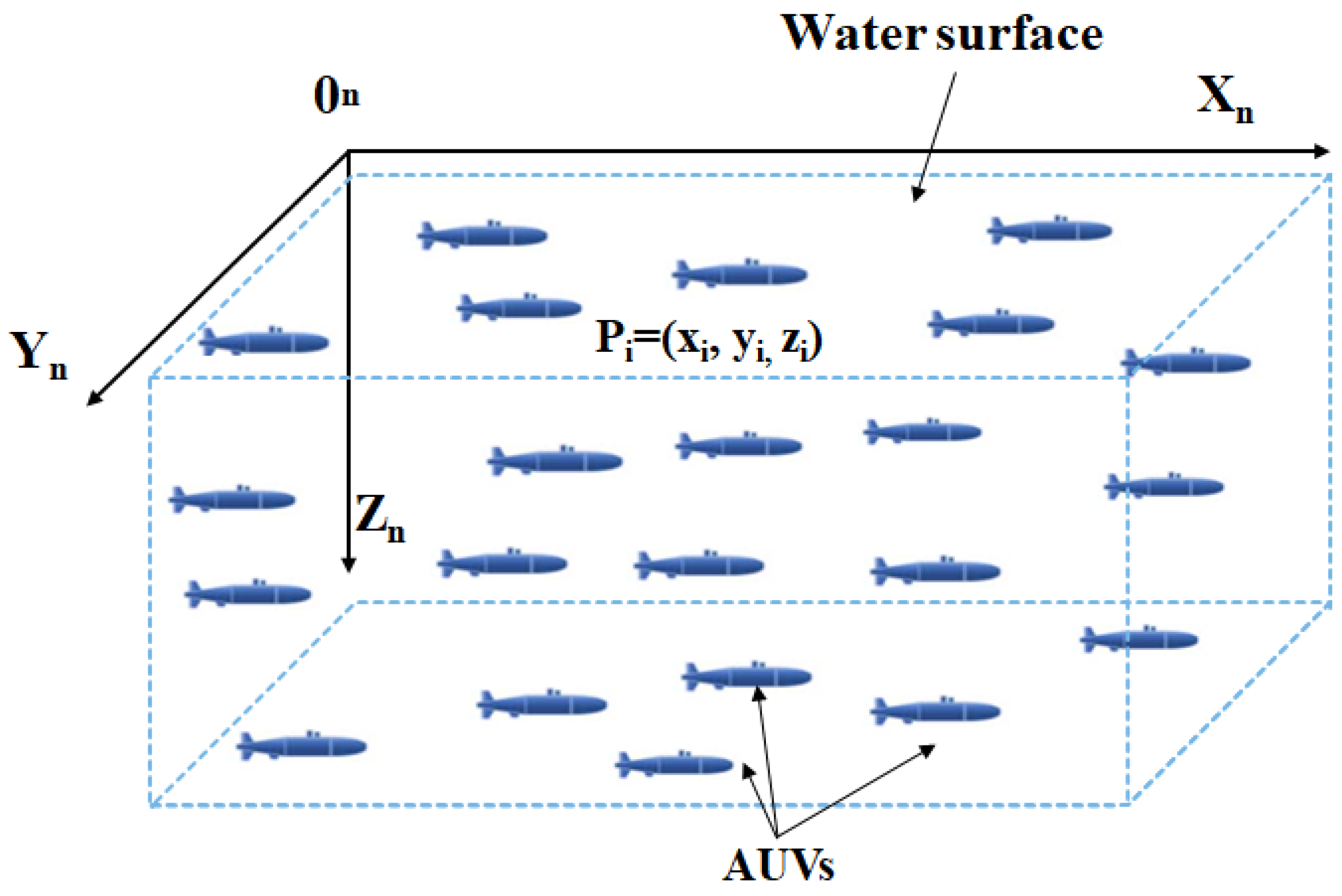
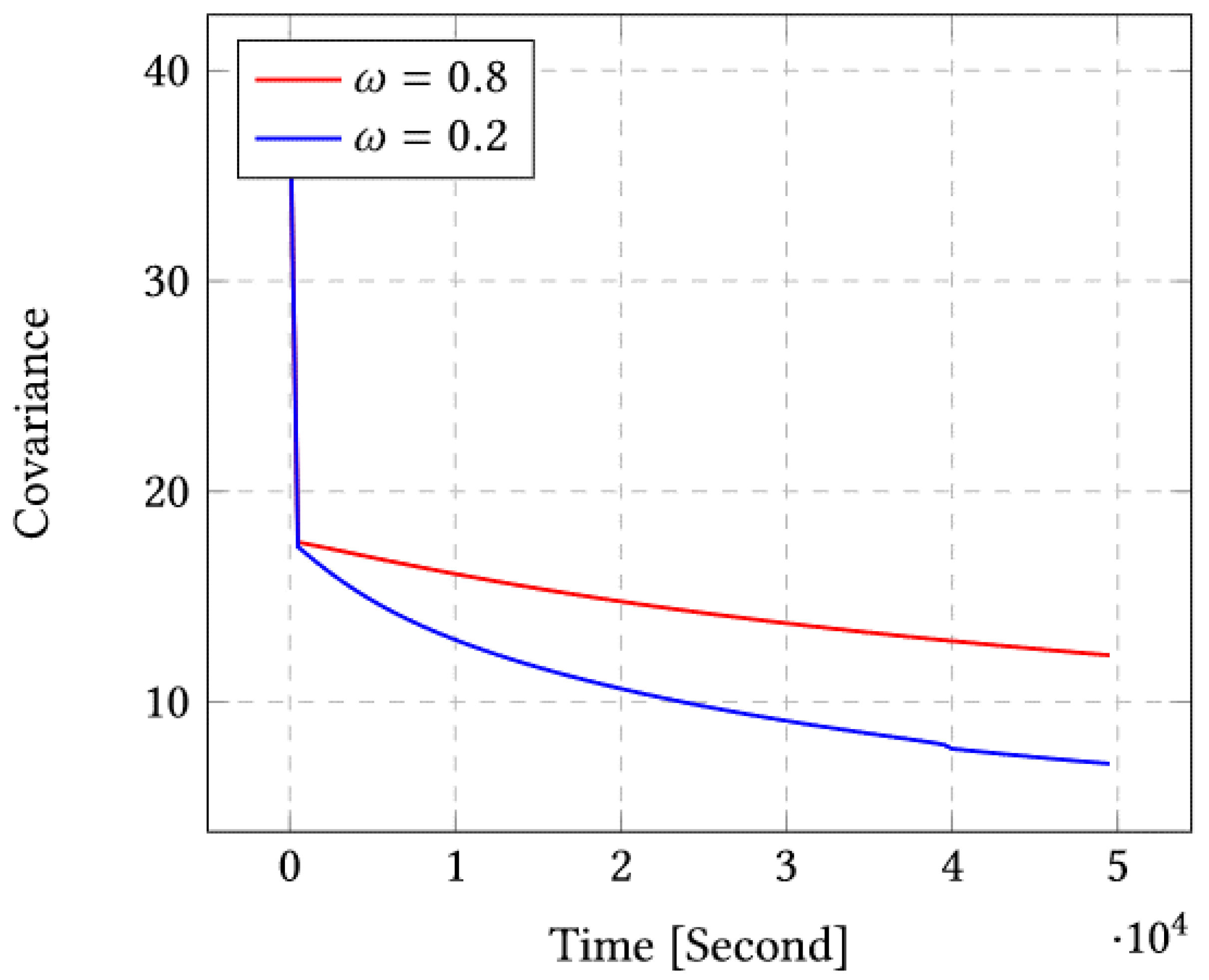
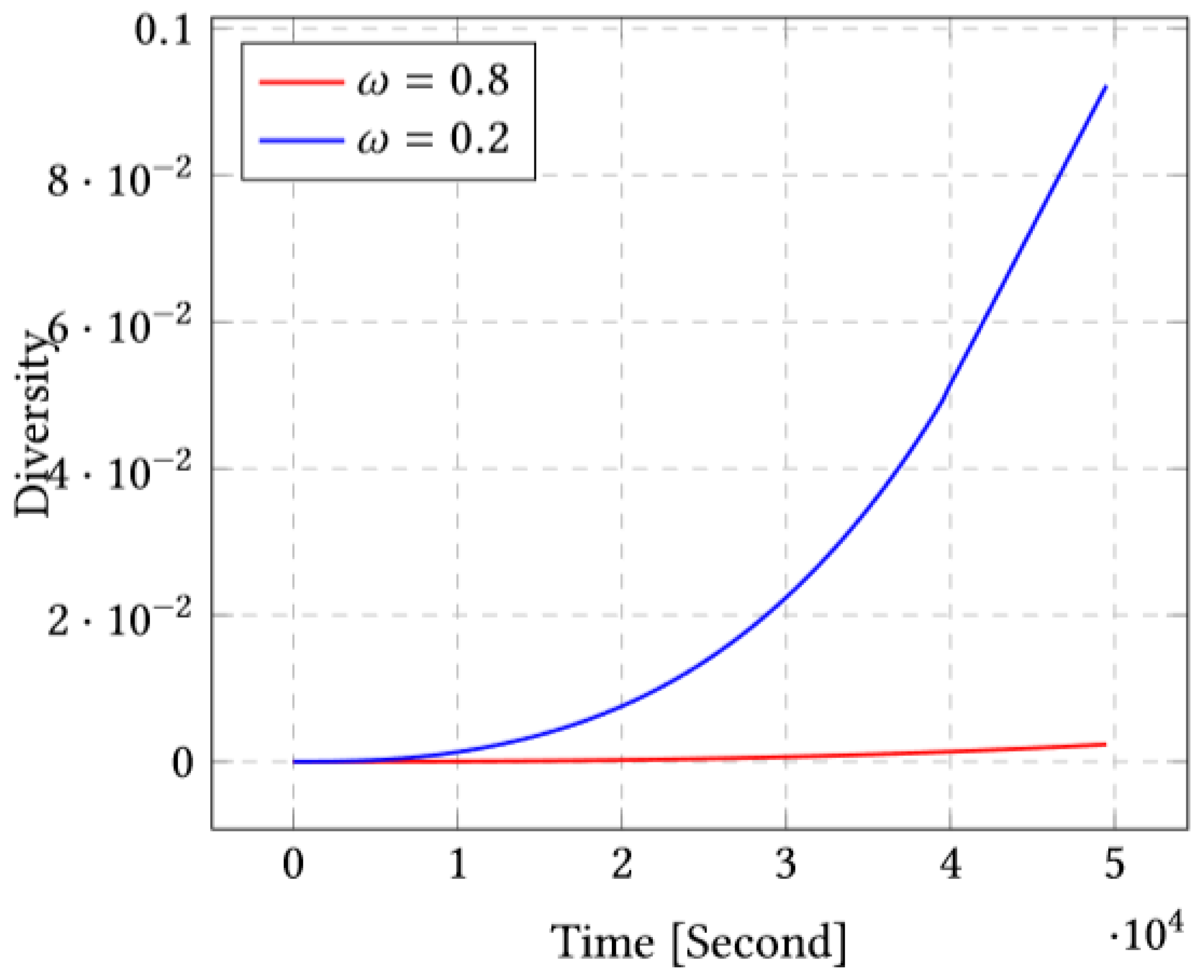
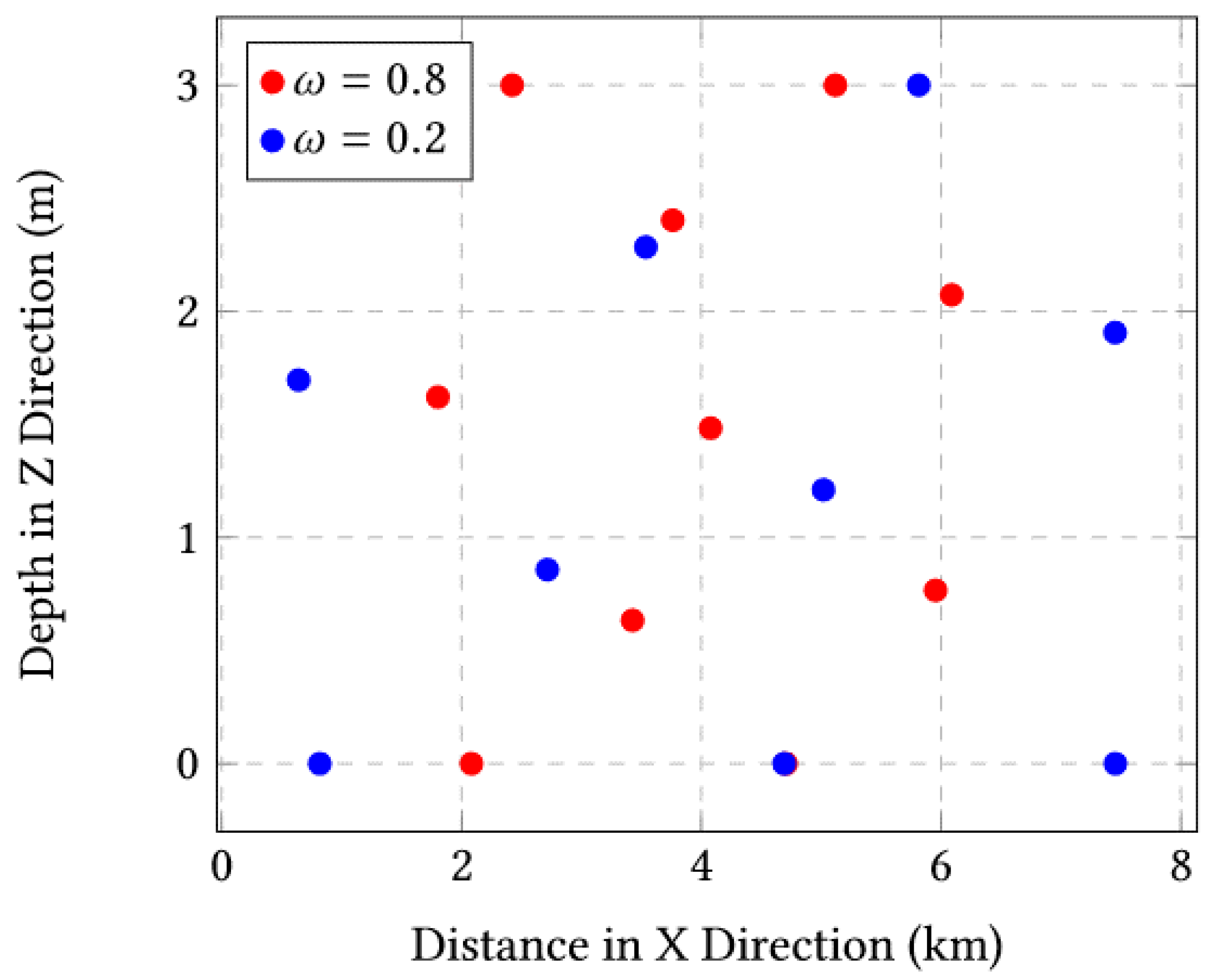
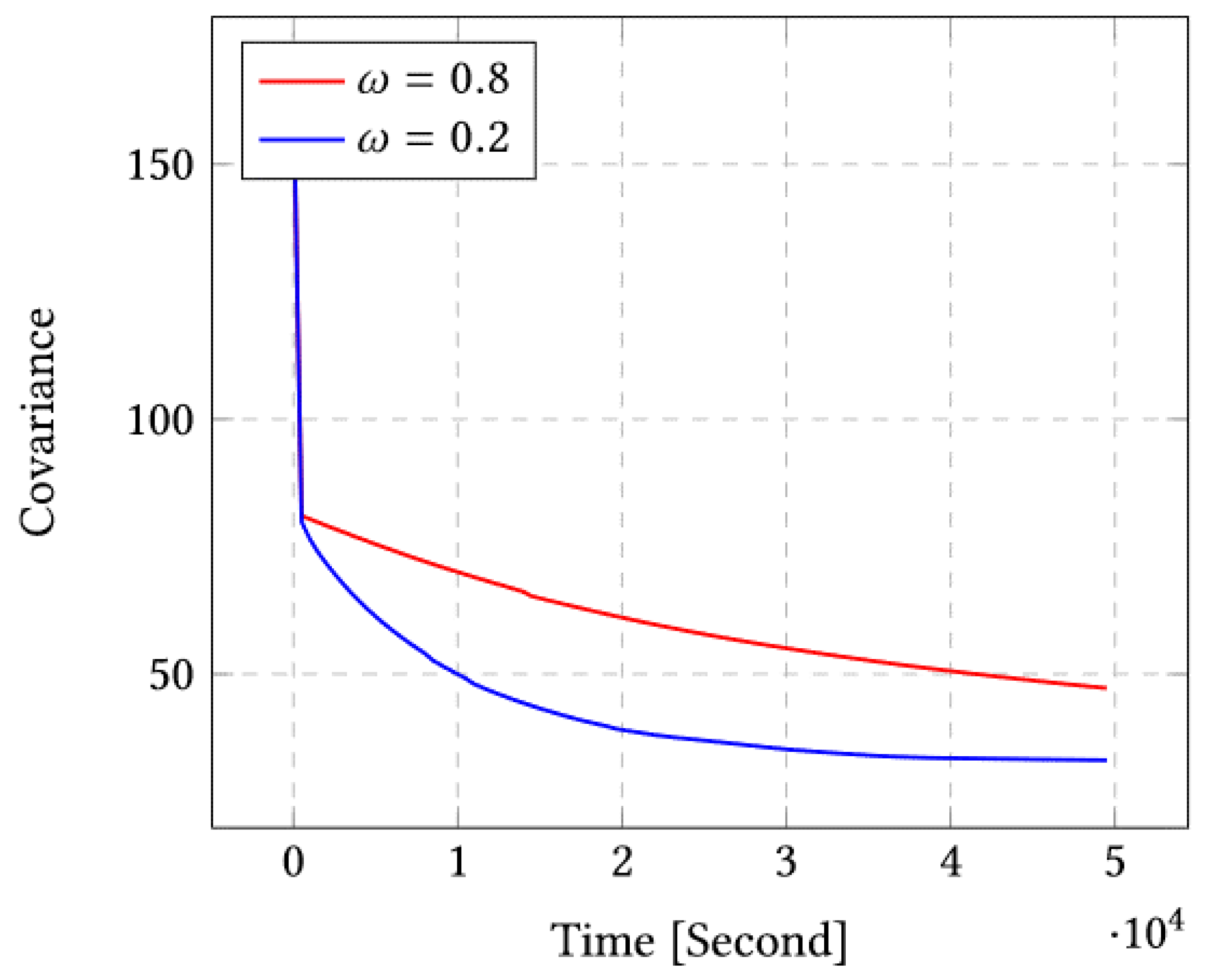

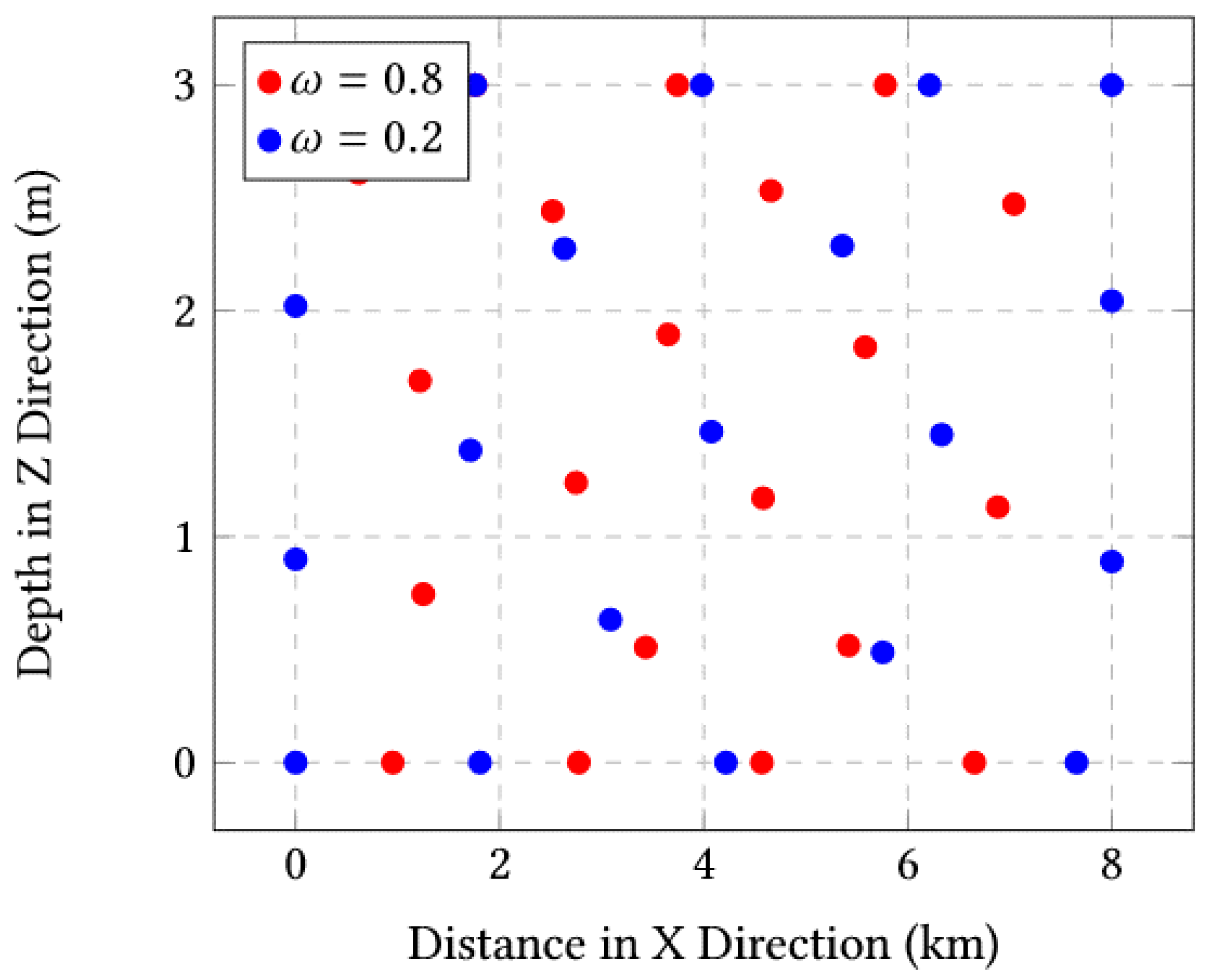
| Reference | Used Approach | Optimization Algorithm | Objective Function |
|---|---|---|---|
| [25] | Multiagent approach | Gradient descent | Objective function based on the inverse of the sum of covariance between measured signals at sensors and points of interest |
| [38] | Algorithm based on Wolf Search | Wolf Search | Network coverage in terms of detection probability while accounting obstacle avoidance |
| [39] | Genetic algorithm-based | Elitist nonselective genetic algorithm (NSGAII) | Difference between measured signals and real signal generated by a known trajectory and a ferromagnetic object |
| [40] | DABVF, a distributed node deployment algorithm based on virtual forces | Virtual forces | Improve network coverage, reduce node energy consumption, balance node residual energy, and optimize node distribution |
| [41] | Multiagent target search method (MATSMI) | Multiagent deep deterministic policy gradient (MADDPG) method | Reward function per agent for finding target which decreases for longer discovery time |
| [42] | Range-based whale optimization algorithm | Whale optimization algorithm (WOA) | Best localization coverage, delivery ratio, delay, and energy |
| [43] | A nature inspired algorithm called underwater salp swarm algorithm (USSA) | Salp swarm algorithm | Maximize the number of localized nodes among nonlocalized ones |
| [44] | A hybrid optimization technique | Butterfly optimization and quaternion-based backtracking search optimization (QBSA) | Reducing the localization error based on the received signal strength indicator (RSSI), battery energy, and distance parameters |
| This Work | Multiagent system approach | Gradient descent | Overall covariance among measured signals by sensors and a diversity term |
Disclaimer/Publisher’s Note: The statements, opinions and data contained in all publications are solely those of the individual author(s) and contributor(s) and not of MDPI and/or the editor(s). MDPI and/or the editor(s) disclaim responsibility for any injury to people or property resulting from any ideas, methods, instructions or products referred to in the content. |
© 2023 by the authors. Licensee MDPI, Basel, Switzerland. This article is an open access article distributed under the terms and conditions of the Creative Commons Attribution (CC BY) license (https://creativecommons.org/licenses/by/4.0/).
Share and Cite
Ould-Elhassen Aoueileyine, M.; Bennouri, H.; Berqia, A.; Lind, P.G.; Haugerud, H.; Krejcar, O.; Bouallegue, R.; Yazidi, A. Quality of Monitoring Optimization in Underwater Sensor Networks through a Multiagent Diversity-Based Gradient Approach. Sensors 2023, 23, 3877. https://doi.org/10.3390/s23083877
Ould-Elhassen Aoueileyine M, Bennouri H, Berqia A, Lind PG, Haugerud H, Krejcar O, Bouallegue R, Yazidi A. Quality of Monitoring Optimization in Underwater Sensor Networks through a Multiagent Diversity-Based Gradient Approach. Sensors. 2023; 23(8):3877. https://doi.org/10.3390/s23083877
Chicago/Turabian StyleOuld-Elhassen Aoueileyine, Mohamed, Hajar Bennouri, Amine Berqia, Pedro G. Lind, Hårek Haugerud, Ondrej Krejcar, Ridha Bouallegue, and Anis Yazidi. 2023. "Quality of Monitoring Optimization in Underwater Sensor Networks through a Multiagent Diversity-Based Gradient Approach" Sensors 23, no. 8: 3877. https://doi.org/10.3390/s23083877
APA StyleOuld-Elhassen Aoueileyine, M., Bennouri, H., Berqia, A., Lind, P. G., Haugerud, H., Krejcar, O., Bouallegue, R., & Yazidi, A. (2023). Quality of Monitoring Optimization in Underwater Sensor Networks through a Multiagent Diversity-Based Gradient Approach. Sensors, 23(8), 3877. https://doi.org/10.3390/s23083877









